Ten Years of VIIRS Land Surface Temperature Product Validation
Abstract
:1. Introduction
2. Data Used
2.1. Satellite Data
2.2. Ground Data
2.2.1. SURFRAD Stations
2.2.2. BSRN Stations
2.2.3. ARM Stations
3. Methodology and Data Processing
4. Results
4.1. Validation Results against SURFRAD
4.2. Validation Results against BSRN
4.3. Validation Results against ARM
5. Discussion
6. Conclusions
Author Contributions
Funding
Data Availability Statement
Acknowledgments
Conflicts of Interest
References
- GCOS-200 (GOOS-214). The Global Observing System for Climate: Implementation Needs. Available online: https://library.wmo.int/doc_num.php?explnum_id=3417 (accessed on 12 June 2022).
- Zheng, W.; Wei, H.; Wang, Z.; Zeng, X.; Meng, J.; Ek, M.; Mitchell, K.; Derber, J. Improvement of daytime land surface skin temperature over arid regions in the NCEP GFS model and its impact on satellite data assimilation. J. Geophys. Res. Atmos. 2012, 117, D06117. [Google Scholar] [CrossRef] [Green Version]
- Trigo, I.F.; Boussetta, S.; Viterbo, P.; Balsamo, G.; Beljaars, A.; Sandu, I. Comparison of model land skin temperature with remotely sensed estimates and assessment of surface-atmosphere coupling. J. Geophys. Res. Atmos. 2015, 120, 12096–12111. [Google Scholar] [CrossRef] [Green Version]
- Fang, L.; Zhan, X.; Schull, M.; Kalluri, S.; Laszlo, I.; Yu, P.; Carter, C.; Hain, C.; Anderson, M. Evapotranspiration Data Product from NESDIS GET-D System Upgraded for GOES-16 ABI Observations. Remote Sens. 2019, 11, 2639. [Google Scholar] [CrossRef] [Green Version]
- Sun, J.; Salvucci, G.D.; Entekhabi, D. Estimates of evapotranspiration from MODIS and AMSR-E land surface temperature and moisture over the Southern Great Plains. Remote Sens. Environ. 2012, 127, 44–59. [Google Scholar] [CrossRef]
- Anderson, M.C.; Allen, R.G.; Morse, A.; Kustas, W.P. Use of Landsat thermal imagery in monitoring evapotranspiration and managing water resources. Remote Sens. Environ. 2012, 122, 50–65. [Google Scholar] [CrossRef]
- Yin, J.; Zhan, X.; Liu, J.; Moradkhani, H.; Fang, L.; Walker, J.P. Near-real-time one-kilometre Soil Moisture Active Passive soil moisture data product. Hydrol. Processes 2020, 34, 4083–4096. [Google Scholar] [CrossRef]
- Rajasekar, U.; Weng, Q. Urban heat island monitoring and analysis by data mining of MODIS imageries. ISPRS J. Photogramm. Remote Sens. 2009, 64, 86–96. [Google Scholar] [CrossRef]
- Weng, Q.; Lu, D.; Schubring, J. Estimation of land surface temperature vegetation abundance relationship for urban heat island studies. Remote Sens. Environ. 2004, 89, 467–483. [Google Scholar] [CrossRef]
- Wan, Z.; Dozier, J. A generalized split-window algorithm for retrieving land-surface temperature measurement from space. IEEE Trans. Geosci. Remote Sens. 1996, 34, 892–905. [Google Scholar]
- Yu, Y.; Tarpley, D.; Privette, J.; Goldberg, M.; Raja, M.; Vinnikov, K.; Xu, H. Developing algorithm for operational GOES-R land surface temperature product. IEEE Trans. Geosci. Remote Sens. 2009, 47, 936–951. [Google Scholar]
- Trigo, I.; Freitas, S.; Bioucas-Dias, J.; Barroso, C.; Monteiro, I.; Viterbo, P. Algorithm Theoretical Basis Document for Land Surface Temperature (LST) Products: LSA-001(MLST), LSA-050 (MLST-R). 2017. Available online: https://landsaf.ipma.pt/en/products/land-surface-temperature/lst/ (accessed on 23 August 2019).
- Prata, A.J. Land Surface Temperature Measurement from Space: AATSR Algorithm Theoretical Basis Document. Available online: https://earth.esa.int/c/document_library/et_file?folderId=13019&name=DLFE-660.pdf (accessed on 12 June 2022).
- Remedios, J. Sentinel-3 Optical Products and Algorithm Definition: Land Surface Temperature Algorithm Theoretical Basis Document. Available online: https://sentinels.copernicus.eu/web/sentinel/user-guides/sentinel-3-slstr/document-library (accessed on 12 June 2022).
- Liu, Y.; Yu, Y.; Yu, P.; Göttsche, F.M.; Trigo, I.F. Quality Assessment of SNPP VIIRS Land Surface Temperature Product. Remote Sens. 2015, 7, 12215–12241. [Google Scholar] [CrossRef] [Green Version]
- Liu, Y.; Yu, Y.; Yu, P.; Wang, H.; Rao, Y. Enterprise LST Algorithm Development and Its Evaluation with NOAA 20 Data. Remote Sens. 2019, 11, 2003. [Google Scholar] [CrossRef] [Green Version]
- Li, H.; Sun, D.; Yu, Y.; Wang, H.; Liu, Y.; Liu, Q.; Du, Y.; Wang, H.; Cao, B. Evaluation of the VIIRS and MODIS LST products in an arid area of Northwest China. Remote Sens. Environ. 2014, 142, 111–121. [Google Scholar] [CrossRef] [Green Version]
- Guillevic, P.C.; Biard, C.J.; Hulley, G.C.; Privette, J.L.; Hook, S.J.; Olioso, A.; Göttsche, F.M.; Radocinski, R.; Román, M.O.; Yu, Y.; et al. Validation of land surface temperature products derived from the Visible Infrared Imaging Radiometer Suite (VIIRS) using ground-based and heritage satellite measurements. Remote Sens. Environ. 2014, 154, 19–37. [Google Scholar] [CrossRef]
- Li, S.; Yu, Y.; Sun, D.; Tarpley, D.; Zhan, X.; Chiu, L. Evaluation of 10 year AQUA/MODIS land surface temperature with SURFRAD observations. Int. J. Remote Sens. 2014, 35, 830–856. [Google Scholar] [CrossRef]
- Yu, Y.; Yu, P. Land Surface Temperature Product from the GOES-R Series. In A new Generation of Geostationary Environmental Satellites; The GOES-R Series; Elsevier: Amsterdam, The Netherlands, 2019; pp. 133–144. [Google Scholar] [CrossRef]
- Martin, M.A.; Ghent, D.; Pires, A.C.; Göttsche, F.-M.; Cermak, J.; Remedios, J.J. Comprehensive in Situ Validation of Five Satellite Land Surface Temperature Data Sets over Multiple Stations and Years. Remote Sens. 2019, 11, 479. [Google Scholar] [CrossRef] [Green Version]
- Sun, D.L.; Pinker, R.T.; Basara, J.B. Land surface temperature estimation from the next generation of Geostationary Operational Environmental Satellites: GOES M-Q. J. Appl. Meteorol. 2004, 43, 363–372. [Google Scholar] [CrossRef]
- Martin, M.A.; Göttsche, F.-M. Satellite LST Validation Report (DEL-13). ESA DUE Glob Temperature Project, Reference GlobT-WP4-DEL-12. 2016. Available online: www.globtemperature.info (accessed on 8 June 2022).
- Wang, H.; Yu, Y.; Yu, P.; Liu, Y. Land Surface Emissivity Product for NOAA JPSS and GOES-R Missions: Methodology and Evaluation. IEEE Trans. Geosci. Remote Sens. 2020, 58, 307–318. [Google Scholar] [CrossRef]
- Hulley, G.; Islam, T.; Freepartner, R.; Malakar, N. Visible Infrared Imaging Radiometer Suite (VIIRS) Land Surface Temperature and Emissivity Product Collection 1 Algorithm Theoretical Basis Document. Available online: https://lpdaac.usgs.gov/documents/1332/VNP21_ATBD_V1.pdf (accessed on 12 June 2022).
- Augustine, J.A.; Dutton, E.G. Variability of the surface radiation budget over the United States from 1996 through 2011 from high-quality measurements. J. Geophys. Res. Atmos. 2013, 118, 43–53. [Google Scholar] [CrossRef] [Green Version]
- Augustine, J.A.; Hodges, G.B.; Cornwall, C.R.; Michalsky, J.J.; Medina, C.I. An Update on SURFRAD—The GCOS Surface Radiation Budget Network for the Continental United States. J. Atmos. Oceanic Technol. 2005, 22, 1460–1472. [Google Scholar] [CrossRef]
- Yu, Y.; Liu, Y.; Yu, P. Land Surface Temperature Product Development for JPSS and GOES-R Missions. In Reference Module in Earth Systems and Environmental Sciences; Princeton University: Princeton, NJ, USA, 2017. [Google Scholar] [CrossRef]
- Sun, D.; Yu, Y.; Fang, L.; Liu, Y. Toward an operational land surface temperature algorithm for GOES. J. Appl. Meteorol. Clim. 2013, 52, 1974–1986. [Google Scholar] [CrossRef]
- Malakar, N.K.; Hulley, G.C.; Hook, S.J.; Laraby, K.; Cook, M.; Schott, J.R. An Operational Land Surface Temperature Product for Landsat Thermal Data: Methodology and Validation. IEEE Trans. Geosci. Remote Sens. 2018, 56, 5717–5735. [Google Scholar] [CrossRef]
- Zhou, J.; Liang, S.; Cheng, J.; Wang, Y.; Ma, J. The GLASS Land Surface Temperature Product. IEEE J. Sel. Top. Appl. Earth Obs. Remote Sens. 2019, 12, 493–507. [Google Scholar] [CrossRef]
- Ohmura, A.; Dutton, E.G.; Forgan, B.; Fröhlich, C.; Gilgen, H.; Hegner, H.; Heimo, A.; König-Langlo, G.; McArthur, B.; Müller, G.; et al. Baseline Surface Radiation Network (BSRN/WCRP): New Precision Radiometry for Climate Research. Bull. Am. Meteorol. Soc. 1998, 79, 2115–2136. [Google Scholar] [CrossRef] [Green Version]
- Göttsche, F.-M.; Olesen, F.-S.; Bork-Unkelbach, A. Validation of land surface temperature derived from MSG/SEVIRI with in situ measurements at Gobabeb, Namibia. Int. J. Remote Sens. 2013, 34, 3069–3083. [Google Scholar] [CrossRef]
- ARM Observatories. Available online: https://www.arm.gov/capabilities/observatories (accessed on 1 June 2022).
- Li, Z.; Tang, B.; Wu, H.; Ren, H.; Yan, G.; Wan, Z.; Trigo, I.F.; Sobrino, J.A. Satellite-Derived Land Surface Temperature: Current Status and Perspectives. Remote Sens. Environ. 2013, 131, 14–37. [Google Scholar] [CrossRef] [Green Version]
- Goela, P.C.; Cordeiro, C.; Danchenko, S.; Icely, J.; Cristina, S.; Newton, A. Time series analysis of data for sea surface temperature and upwelling components from the southwest coast of Portugal. J. Mar. Syst. 2016, 163, 12–22. [Google Scholar] [CrossRef] [Green Version]
- Hook, S.J.; Vaughan, R.G.; Tonooka, H.; Schladow, S.G. Absolute radiometric in-flight validation of mid infrared and thermal infrared data from ASTER and MODIS on the Terra spacecraft using the lake Tahoe, CA/NV, USA, Automated Validation Site. IEEE Trans. Geosci. Remote Sens. 2007, 45, 1798–1807. [Google Scholar] [CrossRef]
- Guillevic, P.; Göttsche, F.; Nickeson, J.; Hulley, G.; Ghent, D.; Yu, Y.; Trigo, I.; Hook, S.; Sobrino, J.A.; Remedios, J.; et al. Land Surface Temperature Product Validation Best Practice Protocol. Version 1.1. In Good Practices for Satellite-Derived Land Product Validation; Guillevic, P., Göttsche, F., Nickeson, J., Román, M., Eds.; Land Product Validation Subgroup (WGCV/CEOS), 2018; p. 58. [Google Scholar] [CrossRef]
- Li, H.; Li, R.; Yang, Y.; Cao, B.; Bian, Z.; Hu, T.; Du, Y.; Sun, L.; Liu, Q. Temperature-Based and Radiance-Based Validation of the Collection 6 MYD11 and MYD21 Land Surface Temperature Products Over Barren Surfaces in Northwestern China. IEEE Trans. Geosci. Remote Sens. 2021, 59, 1794–1807. [Google Scholar] [CrossRef]
- Li, H.; Yang, Y.; Li, R.; Wang, H.; Cao, B.; Bian, Z.; Hu, T.; Du, Y.; Sun, L.; Liu, Q. Comparison of the MuSyQ and MODIS Collection 6 land surface temperature products over barren surfaces in the Heihe River Basin, China. IEEE Trans. Geosci. Remote Sens. 2019, 57, 8081–8094. [Google Scholar] [CrossRef]
- Knap, W. Basic and Other Measurements of Radiation at Station Cabauw (2021-10); Koninklijk Nederlands Meteorologisch Instituut: De Bilt, The Netherlands, 2021. [CrossRef]
- Trishchenko, A.P.; Luo, Y.; Latifovic, R.; Li, Z. Land Cover Type Distribution Over the ARM SGP Area for Atmospheric Radiation and Environmental Research. In Proceedings of the Fourteenth ARM Science Team Meeting, Albuquerque, NM, USA, 22–26 March 2004. [Google Scholar]


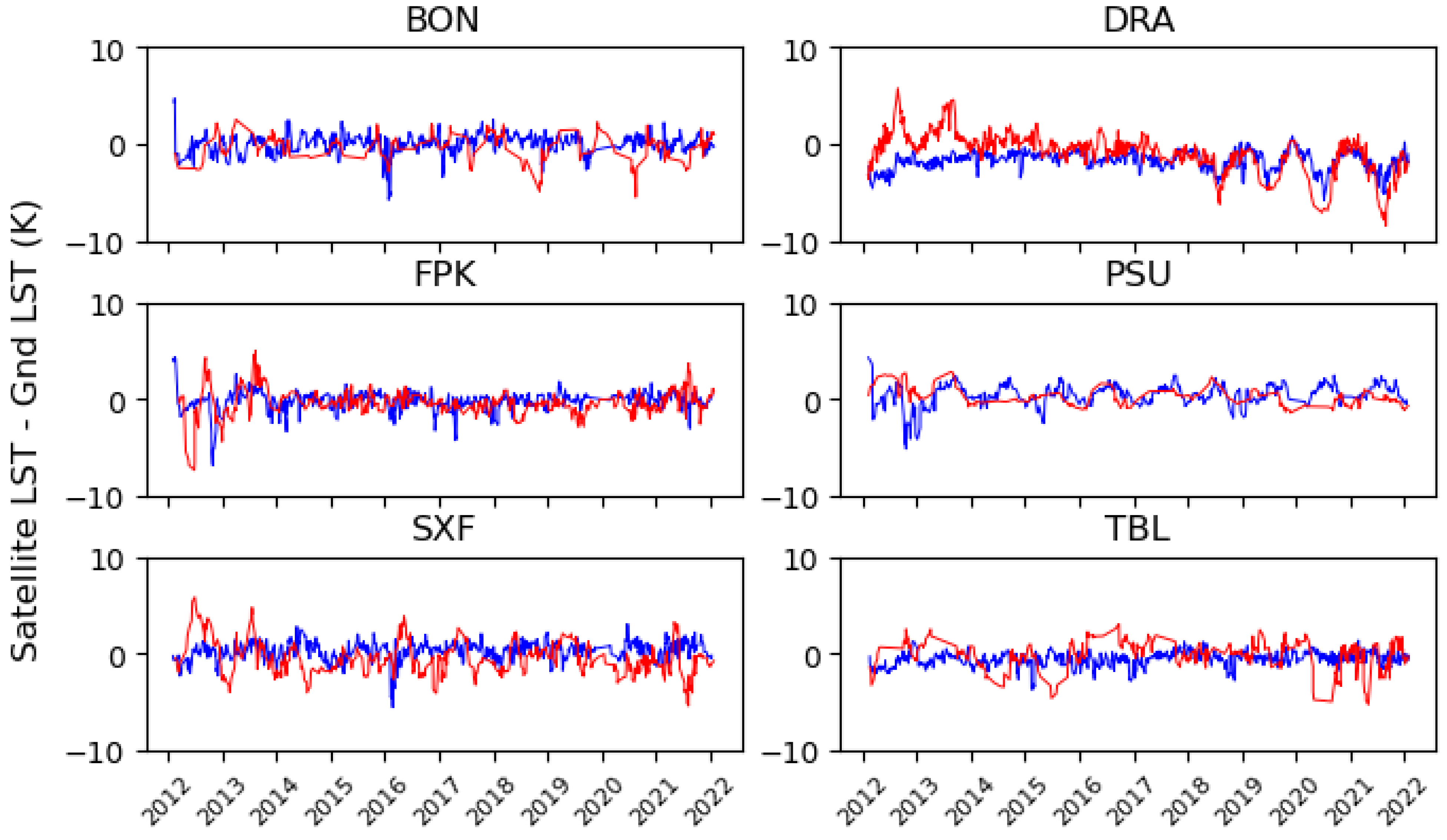


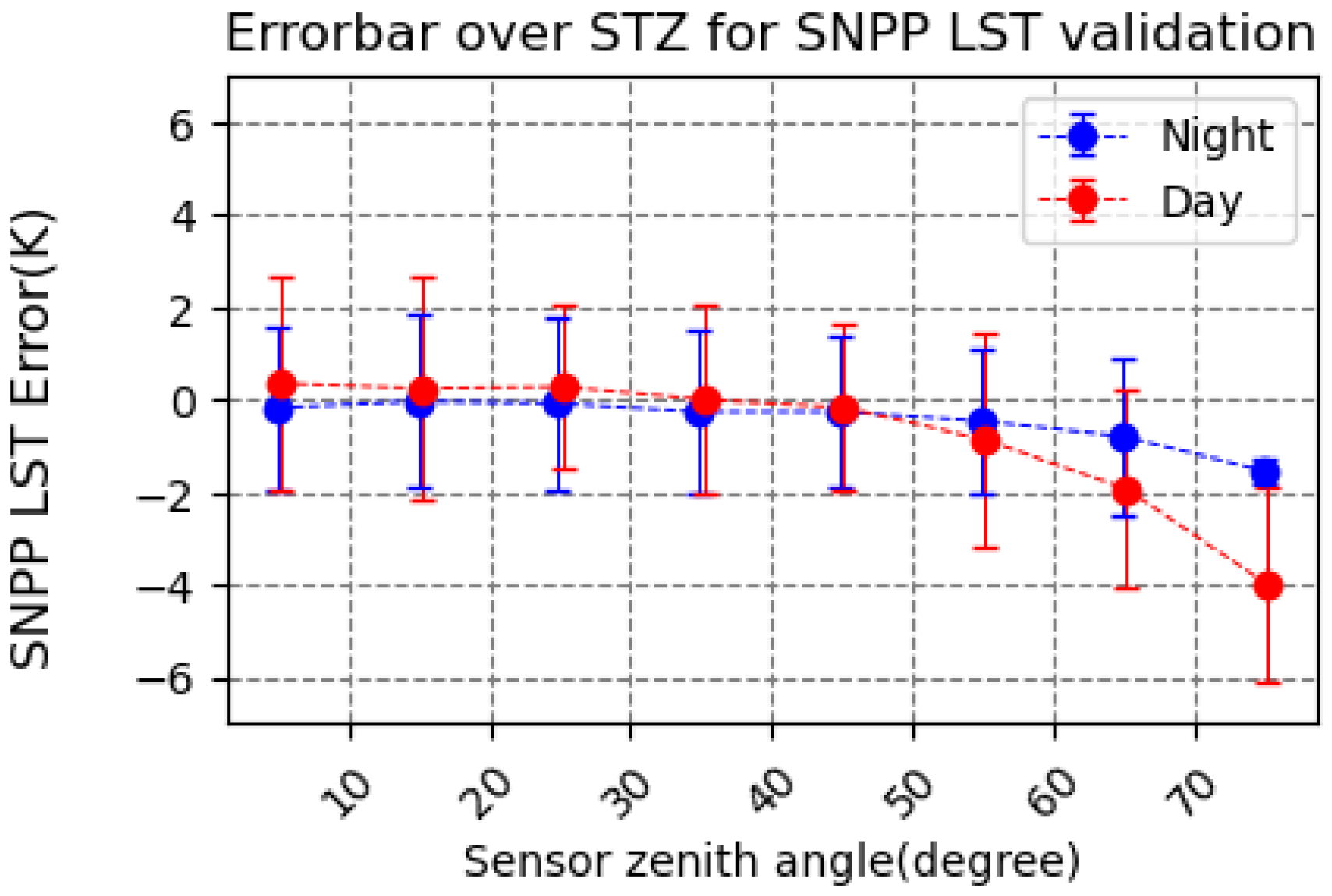
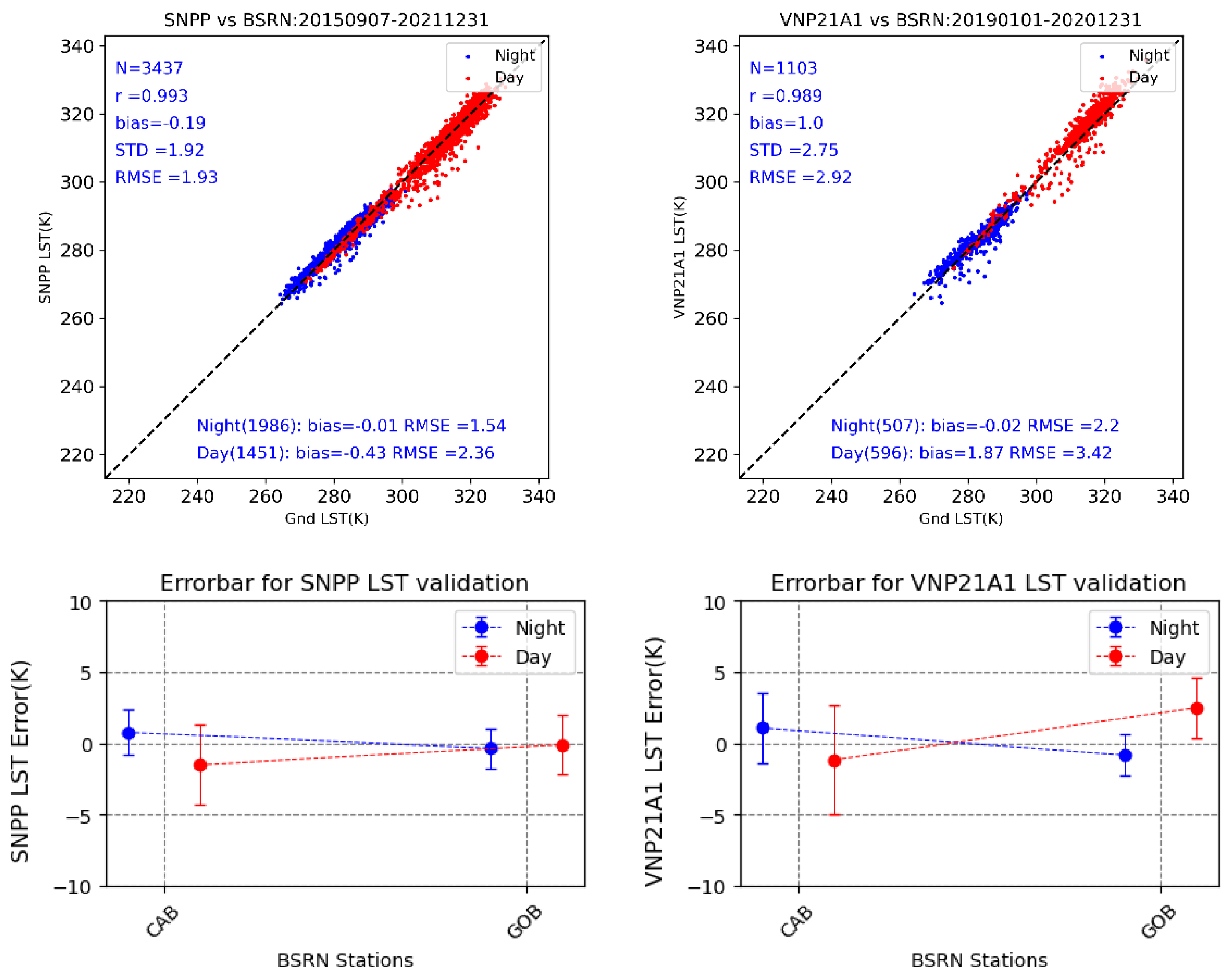
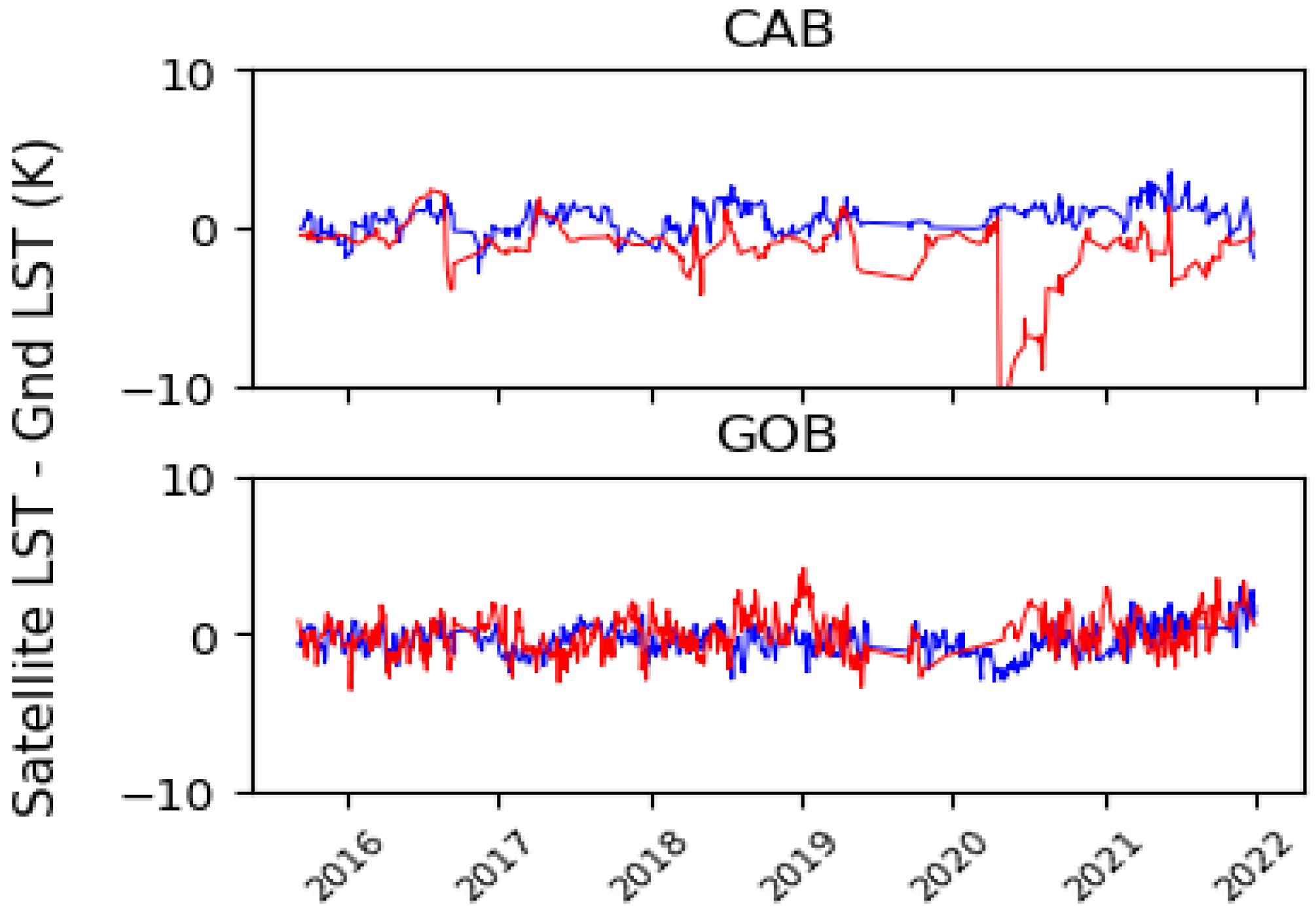
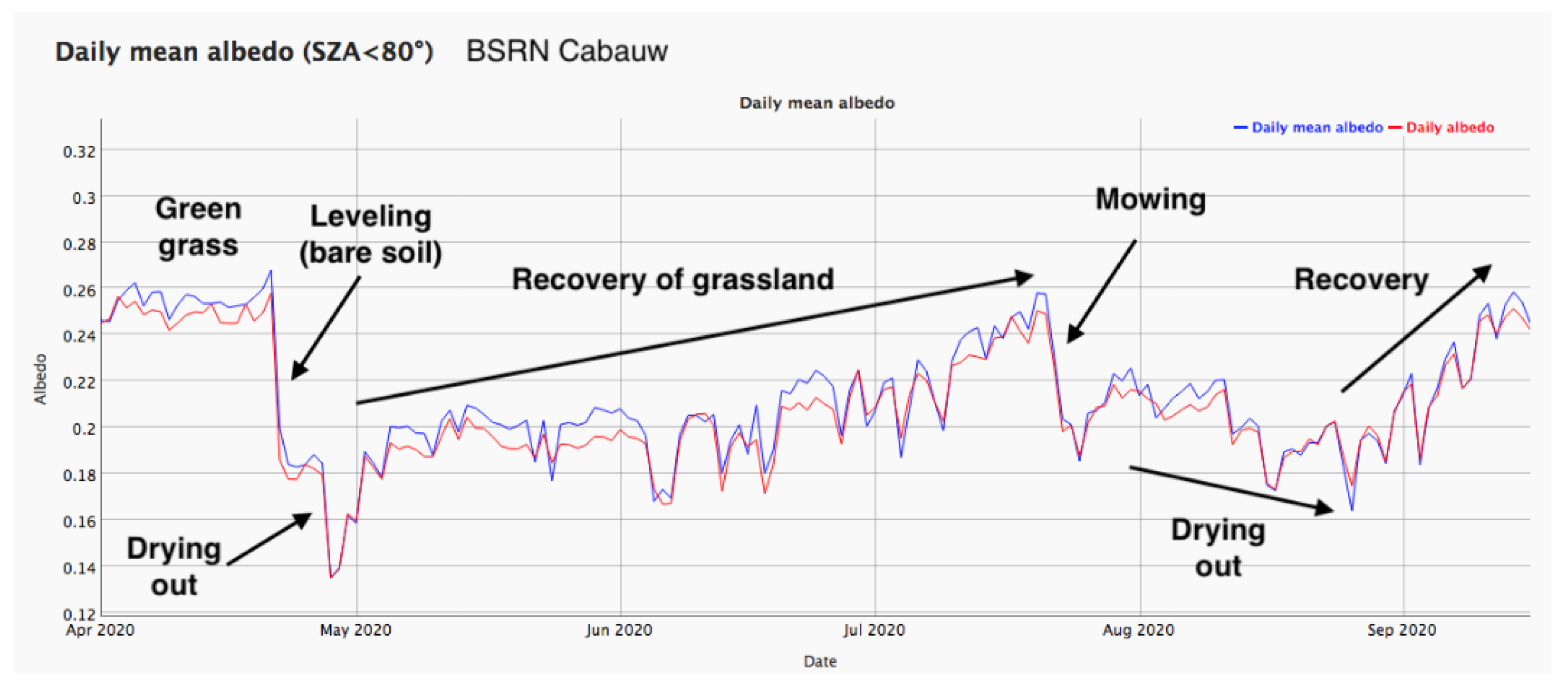

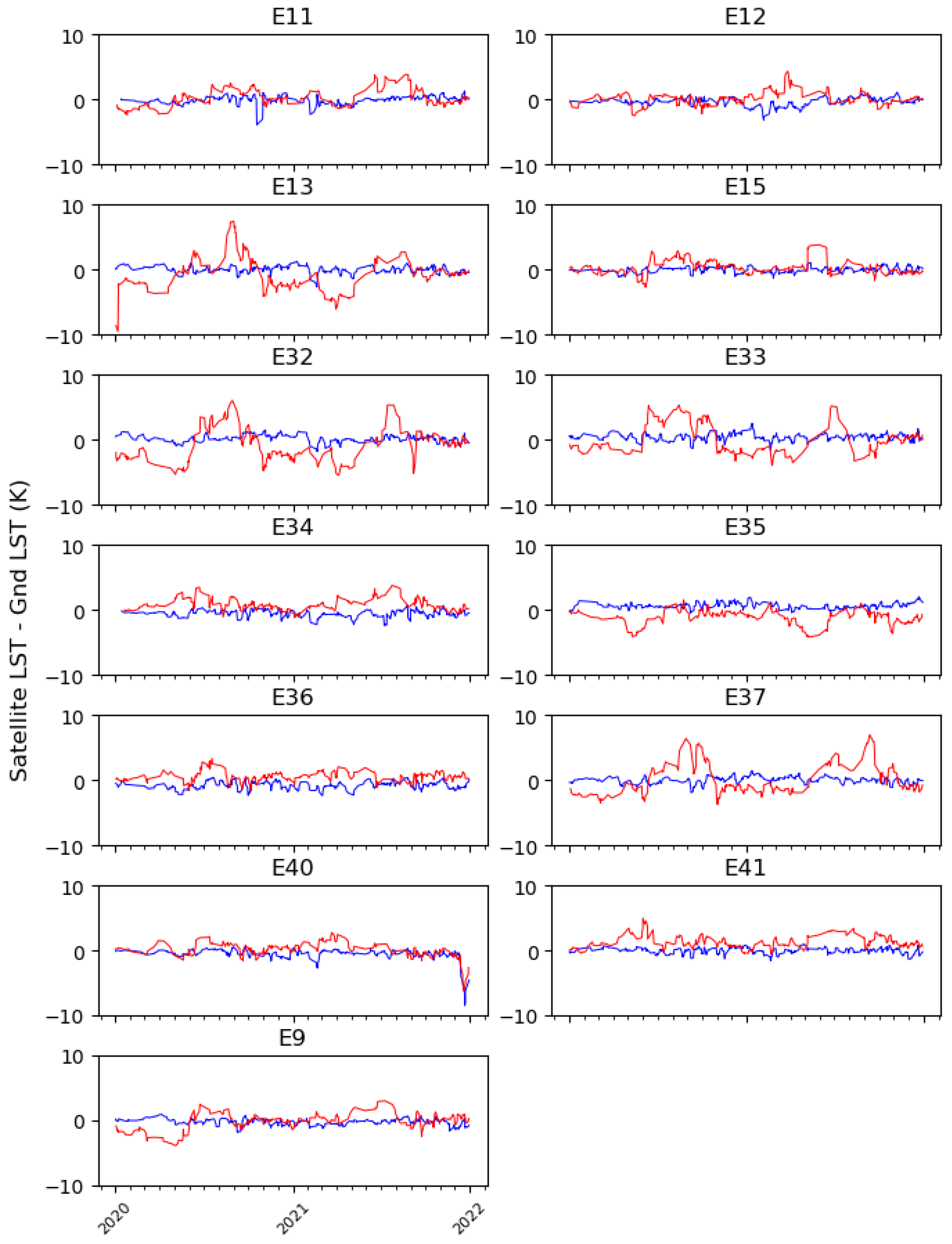


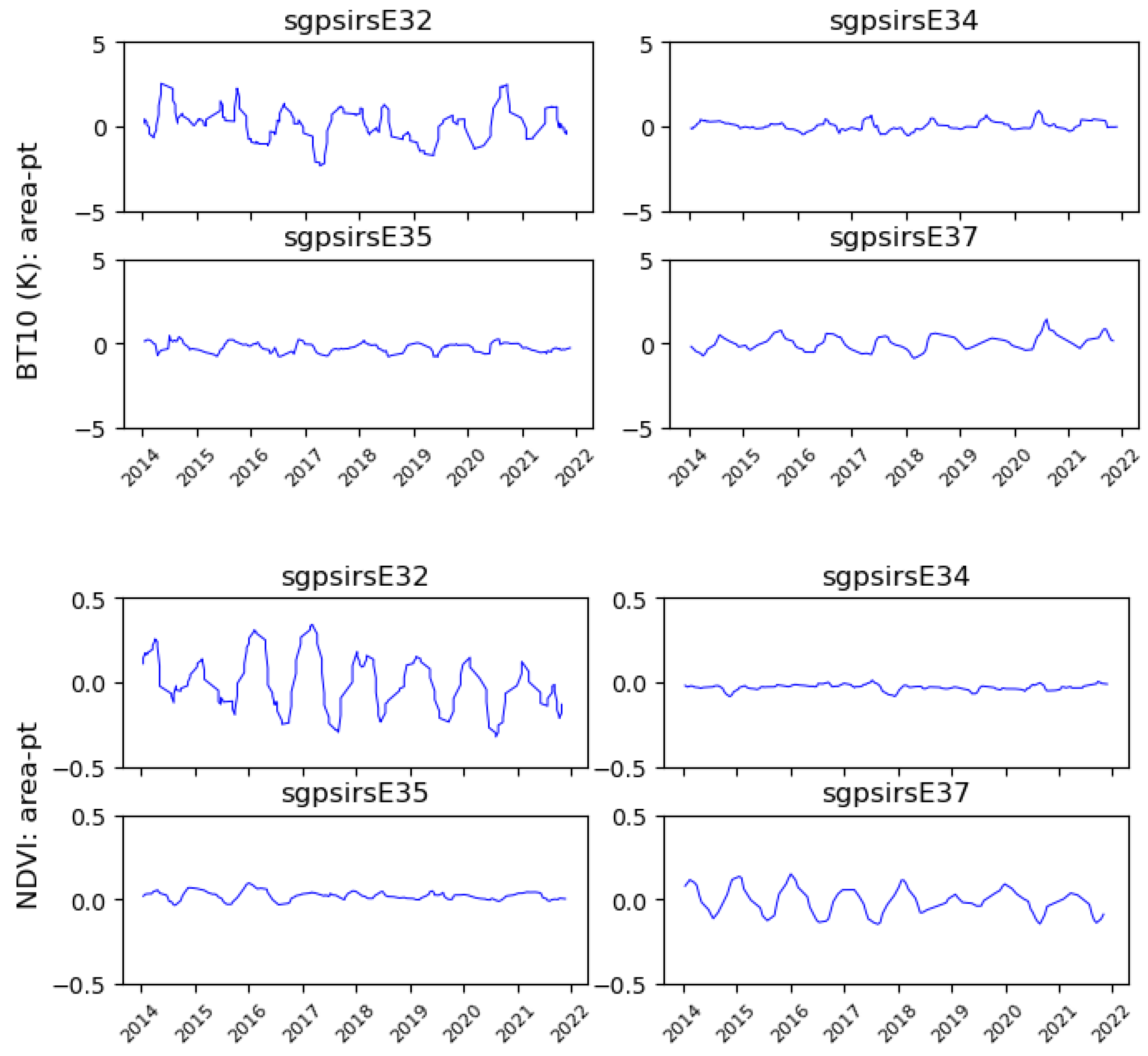
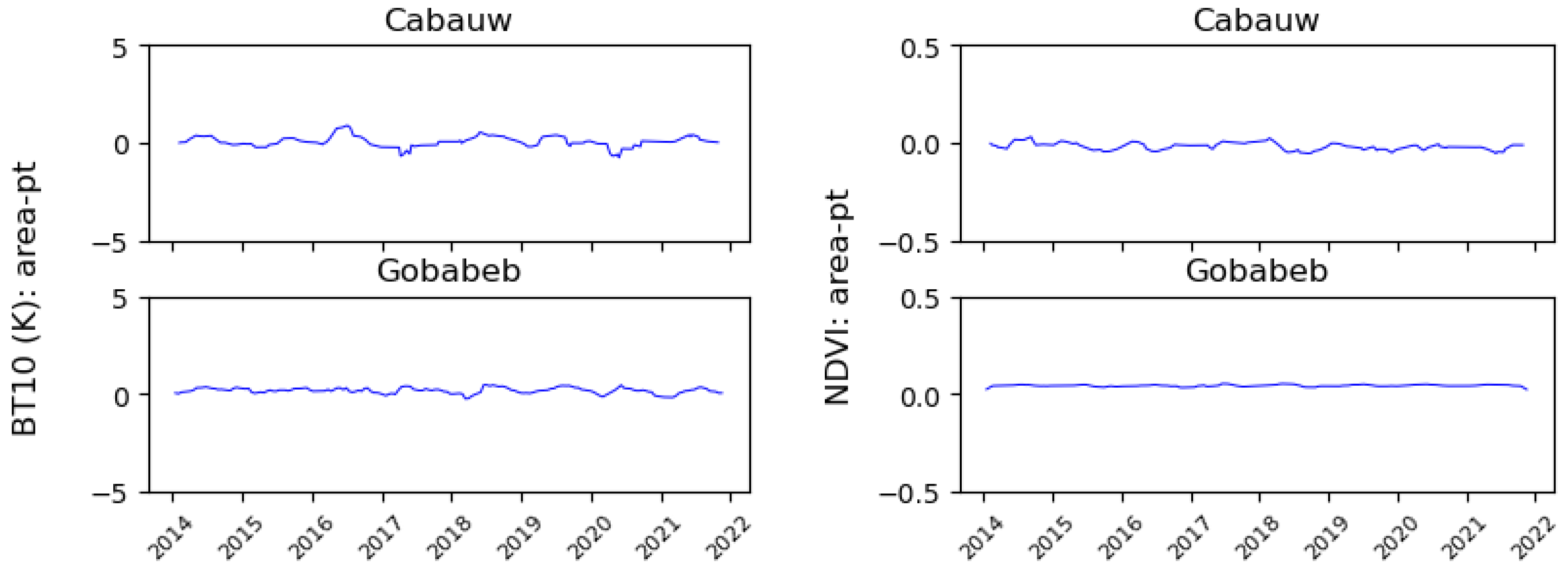
| No. | Site Location | Station Abb. | Lat(N)/Lon(W) | Elevation(m) | Surface Type |
|---|---|---|---|---|---|
| 1 | Bondville, IL, USA | BON | 40.05/88.37 | 230 | Crop Land |
| 2 | Fort Peck, MT, USA | FPT | 48.31/105.10 | 634 | Grass Land |
| 3 | Table Mountain, CO, USA | TBL | 40.13/105.24 | 1689 | Grass/Crop Land |
| 4 | Desert Rock, NV, USA | DRA | 36.63/116.02 | 1007 | Shrub Land |
| 5 | Penn. State Univ., PA, USA | PSU | 40.72/77.93 | 376 | Cropland |
| 6 | Sioux Falls, SD, USA | SFX | 43.73/96.62 | 473 | Cropland |
| No. | Site Location | Station Abb. | Lat(N)/Lon(E) | Elevation(m) | Surface Type |
|---|---|---|---|---|---|
| 1 | Cabauw, The Netherlands | CAB | 51.97/4.93 | 213 | Crop Land |
| 2 | Gobabeb, Namibia | GOB | −23.56/15.04 | 407 | Bare ground |
| No. | Site Name | Station Abb. | Lat(N)/Lon(W) | Altitude(m) | Surface Type |
|---|---|---|---|---|---|
| 1 | sgpsirsE9 | E9 | 37.133/97.266 | 386 | Pasture |
| 2 | sgpsirsE11 | E11 | 36.881/98.285 | 360 | Pasture |
| 3 | sgpsirsE12 | E12 | 36.841/96.427 | 331 | Native Prairie |
| 4 | sgpsirsE13 | E13 | 36.605/97.485 | 318 | Pasture and Wheat |
| 5 | sgpsirsE15 | E15 | 36.431/98.284 | 418 | Pasture |
| 6 | sgpsirsE32 | E32 | 36.819/97.8199 | 328 | Pasture |
| 7 | sgpsirsE33 | E33 | 36.9255/97.0817 | 357 | Grassy field |
| 8 | sgpsirsE34 | E34 | 37.0694/96.7606 | 417 | Pasture |
| 9 | sgpsirsE35 | E35 | 35.8615/97.0695 | 294.1 | Pasture |
| 10 | sgpsirsE36 | E36 | 36.1166/97.5112 | 336.8 | Pasture |
| 11 | sgpsirsE37 | E37 | 36.3106/97.928 | 378.9 | Grass |
| 12 | sgpsirsE40 | E40 | 36.31937/96.76203 | 247 | Pasture |
| 13 | sgpsirsE41 | E41 | 36.87956/97.08645 | 340 | Grassy field |
| Day/Night | Factors | BON | DRA | FPK | PSU | SXF | TBL |
|---|---|---|---|---|---|---|---|
| Night | TPW | −0.2 | −0.52 | −0.24 | 0.15 | 0.01 | −0.1 |
| STZ | −0.25 | −0.16 | −0.29 | −0.03 | −0.08 | −0.23 | |
| emiMean | −0.17 | −0.04 | −0.02 | 0.1 | 0.21 | 0.01 | |
| emiDiff | −0.15 | −0.03 | 0.06 | 0.32 | −0.13 | 0.09 | |
| Day | TPW | −0.55 | −0.49 | 0.18 | 0.11 | −0.17 | −0.18 |
| STZ | −0.09 | −0.33 | −0.48 | −0.25 | −0.49 | −0.58 | |
| emiMean | −0.7 | −0.02 | −0.04 | 0.11 | −0.35 | −0.35 | |
| emiDiff | −0.2 | −0.01 | 0.01 | −0.02 | −0.01 | −0.18 |
Publisher’s Note: MDPI stays neutral with regard to jurisdictional claims in published maps and institutional affiliations. |
© 2022 by the authors. Licensee MDPI, Basel, Switzerland. This article is an open access article distributed under the terms and conditions of the Creative Commons Attribution (CC BY) license (https://creativecommons.org/licenses/by/4.0/).
Share and Cite
Liu, Y.; Yu, P.; Wang, H.; Peng, J.; Yu, Y. Ten Years of VIIRS Land Surface Temperature Product Validation. Remote Sens. 2022, 14, 2863. https://doi.org/10.3390/rs14122863
Liu Y, Yu P, Wang H, Peng J, Yu Y. Ten Years of VIIRS Land Surface Temperature Product Validation. Remote Sensing. 2022; 14(12):2863. https://doi.org/10.3390/rs14122863
Chicago/Turabian StyleLiu, Yuling, Peng Yu, Heshun Wang, Jingjing Peng, and Yunyue Yu. 2022. "Ten Years of VIIRS Land Surface Temperature Product Validation" Remote Sensing 14, no. 12: 2863. https://doi.org/10.3390/rs14122863
APA StyleLiu, Y., Yu, P., Wang, H., Peng, J., & Yu, Y. (2022). Ten Years of VIIRS Land Surface Temperature Product Validation. Remote Sensing, 14(12), 2863. https://doi.org/10.3390/rs14122863






